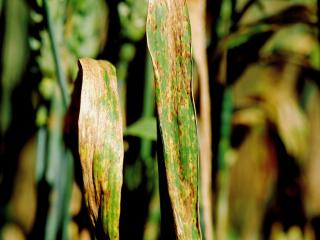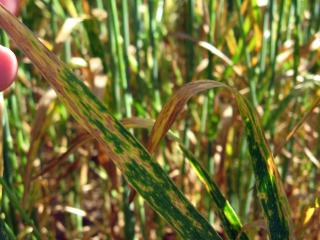Nodorum blotch and yellow spot in wheat
- Geraldton
- Dalyup
- Coomalbidgup
Plant pathologist Ciara Beard (DPIRD) recently found nodorum blotch and yellow spot in flowering regrowth wheat on a roadside near Geraldton and symptoms are becoming evident in sown crops.
Agworld users have reported finding yellow spot in wheat near Geraldton, and nodorum blotch near Dalyup and Coomalbidgup
The disease nodorum blotch (previously known as septoria nodorum blotch) is caused by the fungus Parastagonospora nodorum. Yellow spot is caused by the fungus Pyrenophora tritici-repentis.
In WA, nodorum blotch and yellow spot often occur together as a disease complex on wheat, and are difficult to visually distinguish.
These pathogens are stubble-borne and are therefore high risk in wheat-on-wheat situations. Crop infection is favoured by warm, wet weather. Nodorum blotch is promoted by heavy and frequent rain, while dew can be enough to spread yellow spot. Infected regrowth poses a negligible risk to crops in the region, and demonstrates that proximity to infected stubble is a key risk in the disease cycle.
Symptoms
Plant leaves infected with nodorum blotch have tan-brown oval or irregular shaped leaf blotches with yellow margins. Tiny brown fruiting bodies can occasionally be seen in lesions, but are not easily visible to the naked eye. Badly affected leaves die back from the tip as blotches converge.
Later in the season, nodorum blotch can spread to glumes (known as glume blotch) and stems, and heavy infection may cause blotching across the entire grain head. Shrivelled grain at harvest causes yield and grain quality losses. For information, refer to DPIRD’s diagnosing septoria nodorum of wheat page.
Yellow spot lesions often start as yellow-tan oval spots on leaves that become tan-brown in their centre with a yellow edge as lesions grow. Fruiting bodies are not present in leaf lesions. It is very difficult to distinguish yellow spot from nodorum blotch by visual leaf symptoms, even for experienced plant pathologists who rely on lab diagnostic techniques to confirm which pathogen is present. Heads and glumes are rarely affected with yellow spot. For more information, refer to DPIRD’s diagnosing yellow spot of wheat page.
For diagnosis of which pathogen is causing the symptoms, leaf samples can be submitted to DPIRD’s Diagnostic and Laboratory Services (DDLS) Plant pathology services. Correct diagnosis can be worthwhile, particularly as symptoms may not actually be fungal. Leaf spot symptoms can sometimes be physiological, and these do not respond to fungicide application. Samples can be delivered in-person or addressed to:
DPIRD Diagnostics and Laboratory Services
DDLS Specimen Reception Interim Lab Building 102
Department of Primary Industries and Regional Development
3 Baron-Hay Court
South Perth WA 6151
For more information, email or phone DDLS on +61 (0)8 9368 3721.
Management
Varieties differ in susceptibility to nodorum blotch and yellow spot.
Greatest yield response to fungicide application for nodorum blotch or yellow spot in wheat canopy is achieved through application at flag leaf emergence. However, earlier application (e.g., at first node, Z31) may be considered if a susceptible variety has been sown into wheat stubble. Earlier application may also be considered if disease pressure is high early, particularly when there is yellow spot present. When nodorum is seen moving up the leaf canopy after flag leaf emergence, infection of heads (glume blotch) is a risk, and this can cause significant loss of yield and grain quality. Glume blotch is best prevented by application of a registered fungicide when the crop is at grain ear emergence (Z55 - 59).
Growers should prioritise disease management of wheat sown on wheat stubble, especially early sown susceptible wheat crops, as these are likely to be more vulnerable to developing disease, especially glume blotch, because they have heads exposed for longer.
YellowSpotWM is a free app available to assist with making economic fungicide spray decisions for managing yellow spot in wheat. Users can specify factors relating to paddock selection, variety, seasonal conditions, prices and management options so that the output relates to their cropping circumstance. For more information refer to DPIRD’s YellowSpotWM page.
More information on registered fungicides can be found at DPIRD’s registered foliar fungicides for cereals in Western Australia page.
Further information about this disease can be found at the department’s managing yellow spot and nodorum blotch in wheat page.
For more information on wheat diseases, contact Plant Pathologists Andrea Hills in Esperance on +61 (0)8 9083 1144, Ciara Beard in Geraldton on +61 (0)8 9956 8504, Geoff Thomas in South Perth on +61 (0)8 9368 3262, or Kithsiri Jayasena in Albany on +61 (0)8 9892 8477.
Article author: Ciara Beard (DPIRD Geraldton).
Article input: Geoff Thomas (DPIRD South Perth), Kithsiri Jayasena (DPIRD Albany), Jean Galloway (DPIRD Northam) and Manisha Shankar (DPIRD South Perth).


